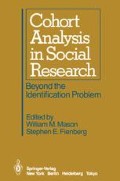Abstract
For the past 80 years or more, social scientists have attempted to analyze cross-time data, using as explanatory variables age and time (or phenomena that are time-specific). When such data are analyzed in aggregate forms, age and time are typically grouped and polytomized. More recently, some investigators have adopted an analytic focus in which cohort membership, as defined by the period and age at which an individual Observation can first enter an age-by-period data array, is held to be more important than age or period for substantive understanding. This focus has led to age-cohort and period-cohort models, as distinguished from age-period models.
Access this chapter
Tax calculation will be finalised at checkout
Purchases are for personal use only
Preview
Unable to display preview. Download preview PDF.
References
Atkinson, A.C. (1970). A method for discriminating between models. Journal of the Royal Statistical Society, Series B 32, 323–353.
Brown, B.W., Jr. (1978). Statistics, scientific method and smoking, in J.M. Tanur et al Statistics: A Guide to the Unknown, Second Edition. San Francisco: Holden-Day, pp. 59–70.
Carr-Hill, R.A., Hope, K., and Stern, N. (1972). Delinquent generations revisited. Quality and Quantity 6, 327–352.
Chuang, J-L. C. (1980). Analysis of categorical data with ordered categories. Ph.D. Dissertation. Minneapolis-St. Paul: School of Statistics, University of Minnesota.
Coale, A.J. and Trussell, T.J. (1974). Model fertility schedules: Variations in the age structure of childbearing in human populations. Population Index 40, 185–257.
Cook, R.D. (1975). Analysis of interactions. Unpublished manuscript, Minneapolis-St. Paul: School of Statistics, University of Minnesota.
Easterlin, R. (1961). The American baby boom in historical perspective. American Economic Review 51, 869–911.
Easterlin, R. (1978). What will 1984 be like? Socioeconomic implications of recent twists in age structure. Demography 15, 397–432.
Farkas, G. (1977). Cohort, age and period effects upon the employment of white females: Evidence for 1957-1968. Demography 14, 843–861.
Featherman, D.L. and Hauser, R.M. (1975). Design for a replicate study of social mobility in the United States, in K. C. Land and S. Spilerman (eds.), Social Indicator Models. New York: Russell Sage Foundation, pp. 219–251.
Fienberg, S.E. and Mason, W.M. (1978). Identification and estimation of age-period-cohort models in the analysis of discrete archival data, in K. F. Schuessler (ed.), Sociological Methodology 1979. San Francisco: Jossey-Bass, pp. 1–67.
Glenn, N.D. (1976). Cohort analysts’ futile quest: Statistical attempts to separate age, period and cohort effects. American Sociological Review 41, 900–904.
Greenberg, B.G., Wright, J.J., and Sheps, C.G. (1950). A technique for analyzing some factors affecting the incidence of syphilis. Journal of the American Statistical Association 251, 373–399.
Haberman, S.J. (1978). Analysis of Qualitative Data. Vol. 1: Introductory Topics. New York: Academic Press.
Hartley, H.O., Sielken, R.L. (1975). A “super-population viewpoint” for finite population sampling. Biometrics 31, 411–422.
Heckman, J. and Robb, R. (1985). Using longitudinal data to estimate age, period and cohort effects in earnings equations. This volume.
International Statistical Institute (1975). The World Fertility Survey: The First Three Years, January 1972-January 1975. The Hague-Voorburg, Netherlands: International Statistical Institute.
Johnson, E.E. and Graybill, F.A. (1972). Analysis of a two-way model with interaction and no replication. Journal of the American Statistical Association 67, 862–868.
Johnson, R.A. (1985). Analysis of age, period and cohort effects in marital fertility. This volume.
Koopmans, T.C. (1949). Identification problems in economic model construction. Econometrica 17, 125–144.
Lazarsfeld, P.F. and Menzel, H. (1961). On the relation between individual and collective properties, in A. Etzioni (ed.), Complex Organizations. New York: Holt, Rinehart and Winston, pp. 422–440.
Mandel, J. (1969). The partitioning of interaction in analysis of variance. Journal of Research of the National Bureau of Standards, B 73B, 4, 309–328.
Mandel, J. (1971). A new analysis of variance model for non-additive data. Technometrics 13, 1–18.
Mare, R.D. (1979). Social background composition and educational growth. Demography 16, 55–71.
Mason, W.M. (1980). Some statistics and methodology of multi-level analysis. Ann Arbor: Population Studies Center of the University of Michigan.
Mason, W.M. and Smith, H.L. (1985). Age-period-cohort analysis and the study of deaths from pulmonary tuberculosis. This volume.
Nesselroade, J.R. and Baltes, P.B. (1974). Adolescent Personality Development and Historical Change: 1970–1972. Monographs of the Society for Research in Child Development, 39 (1, Serial No. 154).
Pullum, T.W. (1977). Parameterizing age, period and cohort effects: An application to U.S. delinquency rates, 1964-1973, in K. F. Schuessler (ed.), Sociological Methodology 1978. San Francisco: Jossey-Bass, pp. 116–140.
Pullum, T.W. (1980). Separating age, period and cohort effects in white U.S. fertility, 1920-1970. Social Science Research 9, 225–244.
Quandt, R.E. (1974). A comparison of methods for testing nonnested hypotheses. Review of Economics and Statistics 41, 92–99.
Ryder, N.B. (1965). The cohort as a concept in the study of social change. American Sociological Review 30, 843–861. Reprinted in this volume.
Smith, D.P. (1981). A reconsideration of Easterlin cycles. Population Studies 35, 247–264.
Tukey, J. (1949). One degree offreedom for non-additivity. Biometrics 5, 232–242.
United States Department of Health, Education and Weifare (1979). Smoking and Health: A Report of the Surgeon General. Washington, D.C.: Government Printing Office.
Winsborough, H.H. (1976). Discussion of “Identification and estimation of age, period and cohort effects in the analysis of discrete archival data” by S.E. Fienberg and Wm. M. Mason. Proceedings of the Social Statistics Section. Pt. 1. Washington, D.C.: American Statistical Association, pp. 138–139.
Wolfgang, M. (1982). Delinquency and birth cohort: I I. Paper presented at the annual meeting of the American Association for the Advancement of Science, Washington, D.C.
Wolfgang, M.E., Figlio, M., and Sellin, T. (1972). Delinquency in a Birth Cohort Chicago: University of Chicago Press.
Author information
Authors and Affiliations
Editor information
Editors and Affiliations
Rights and permissions
Copyright information
© 1985 Springer-Verlag New York Inc.
About this chapter
Cite this chapter
Fienberg, S.E., Mason, W.M. (1985). Specification and Implementation of Age, Period and Cohort Models. In: Mason, W.M., Fienberg, S.E. (eds) Cohort Analysis in Social Research. Springer, New York, NY. https://doi.org/10.1007/978-1-4613-8536-3_3
Download citation
DOI: https://doi.org/10.1007/978-1-4613-8536-3_3
Publisher Name: Springer, New York, NY
Print ISBN: 978-1-4613-8538-7
Online ISBN: 978-1-4613-8536-3
eBook Packages: Springer Book Archive

